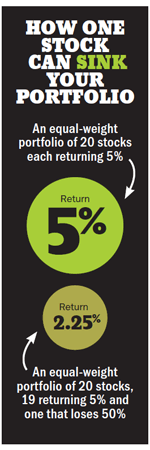Stocks: The hard sell
Investors love to buy stocks, but selling is much harder. All too often pride, anxiety and neglect keep us hanging onto our losing stocks until it's too late
Advertisement
Investors love to buy stocks, but selling is much harder. All too often pride, anxiety and neglect keep us hanging onto our losing stocks until it's too late
 Patricia Price grabs a coffee, powers up her computer, turns on BNN and settles in for another day scouring the investment news on the web for the next stock to buy. When she answers a phone call from MoneySense, it doesn’t take long before she turns the conversation to the mining company Teck, and China’s appetite for resources. “Over the long term copper and coal should do well,” she says. Price delivers her outlook with the confidence of a trader on Bay Street, but in fact she’s a 68-year-old, semi-retired Maritimer in Boiestown, N.B., a speck of a place some 50 minutes north of Fredericton.
Today Price is waffling on her next move for Teck after watching her investment tank. She got in on the diversified miner at $58. Like a wise investor, she lowered her average buying cost by adding to her position when shares dipped to $48, and again when they ticked below $38. She lost patience when the shares bottomed out at $26. Time to move on, but her confidence boils away as talk turns to selling. “I want to take my loss on Teck and put it somewhere I feel is much safer, but because it’s starting to creep up again I hesitate to do that.” You can hear the anxiety in her voice.
It’s like a bad romance. Just when you think you’re ready to break up and move on, you get reeled back in. Price isn’t the only one who feels this way. “You look at a company and it goes nowhere; then it flirts with you by going up a bit and down a bit,” says William Corbett, a retired criminal lawyer in Ottawa who manages his own portfolio. “Selling is an emotional thing.”
Emotions muddy the decision-making process, not just for amateurs like Price and Corbett, but for professionals, too. “Business school taught me how to buy, but selling is intuitive,” says Irwin Michael of ABC Funds. “You have to learn that part on your own.”
Sir John Templeton once said the only time to sell is when you need the money. In practice it’s more complicated. The pros will tell you there aren’t many companies worthy of such devotion—especially in a small concentrated market like Canada.
Investments change over time—even the good ones. Take Eastman Kodak. The film manufacturer was a blue-chip stock for more than 70 years and rewarded long-term investors handsomely, especially those who bought it before the Second World War. And then it didn’t. The proliferation of digital cameras made Kodak irrelevant and it succumbed to bankruptcy in 2012, eight years after losing its place in the Dow.
Investments aren’t the only things that change over time; your needs do, too. You may need to sell for an emergency, to transition your portfolio to focus more on fixed income or even for routine rebalancing. It all boils down to this: how do you identify the right time? Here are how some of the best investment minds in the country decide when it’s time to sell a stock.
Patricia Price grabs a coffee, powers up her computer, turns on BNN and settles in for another day scouring the investment news on the web for the next stock to buy. When she answers a phone call from MoneySense, it doesn’t take long before she turns the conversation to the mining company Teck, and China’s appetite for resources. “Over the long term copper and coal should do well,” she says. Price delivers her outlook with the confidence of a trader on Bay Street, but in fact she’s a 68-year-old, semi-retired Maritimer in Boiestown, N.B., a speck of a place some 50 minutes north of Fredericton.
Today Price is waffling on her next move for Teck after watching her investment tank. She got in on the diversified miner at $58. Like a wise investor, she lowered her average buying cost by adding to her position when shares dipped to $48, and again when they ticked below $38. She lost patience when the shares bottomed out at $26. Time to move on, but her confidence boils away as talk turns to selling. “I want to take my loss on Teck and put it somewhere I feel is much safer, but because it’s starting to creep up again I hesitate to do that.” You can hear the anxiety in her voice.
It’s like a bad romance. Just when you think you’re ready to break up and move on, you get reeled back in. Price isn’t the only one who feels this way. “You look at a company and it goes nowhere; then it flirts with you by going up a bit and down a bit,” says William Corbett, a retired criminal lawyer in Ottawa who manages his own portfolio. “Selling is an emotional thing.”
Emotions muddy the decision-making process, not just for amateurs like Price and Corbett, but for professionals, too. “Business school taught me how to buy, but selling is intuitive,” says Irwin Michael of ABC Funds. “You have to learn that part on your own.”
Sir John Templeton once said the only time to sell is when you need the money. In practice it’s more complicated. The pros will tell you there aren’t many companies worthy of such devotion—especially in a small concentrated market like Canada.
Investments change over time—even the good ones. Take Eastman Kodak. The film manufacturer was a blue-chip stock for more than 70 years and rewarded long-term investors handsomely, especially those who bought it before the Second World War. And then it didn’t. The proliferation of digital cameras made Kodak irrelevant and it succumbed to bankruptcy in 2012, eight years after losing its place in the Dow.
Investments aren’t the only things that change over time; your needs do, too. You may need to sell for an emergency, to transition your portfolio to focus more on fixed income or even for routine rebalancing. It all boils down to this: how do you identify the right time? Here are how some of the best investment minds in the country decide when it’s time to sell a stock.
 The recent takeover of Nexen by China’s CNOOC is an apt illustration. Its shares soared more than 50% after the offer, to within a dollar of the proposed sale price. Holding out for the merger to close would only have netted you an additional 3.8% while Ottawa mulled over the deal. The risk was what would have happened if the decision went the other way. Had that happened the stock likely would have dropped back to its pre-takeover levels, resulting in a loss of 30%.
Given the time it has taken to close this deal and the political posturing around it, it’s hardly worth the risk of giving up the 50% gain for an extra few percentage points. Unless you were expecting a new offer to come in and drive the price higher, in cases like this it’s probably a good time to sell and move on and let someone else assume the risk.
The recent takeover of Nexen by China’s CNOOC is an apt illustration. Its shares soared more than 50% after the offer, to within a dollar of the proposed sale price. Holding out for the merger to close would only have netted you an additional 3.8% while Ottawa mulled over the deal. The risk was what would have happened if the decision went the other way. Had that happened the stock likely would have dropped back to its pre-takeover levels, resulting in a loss of 30%.
Given the time it has taken to close this deal and the political posturing around it, it’s hardly worth the risk of giving up the 50% gain for an extra few percentage points. Unless you were expecting a new offer to come in and drive the price higher, in cases like this it’s probably a good time to sell and move on and let someone else assume the risk.
Share this article Share on Facebook Share on Twitter Share on Linkedin Share on Reddit Share on Email